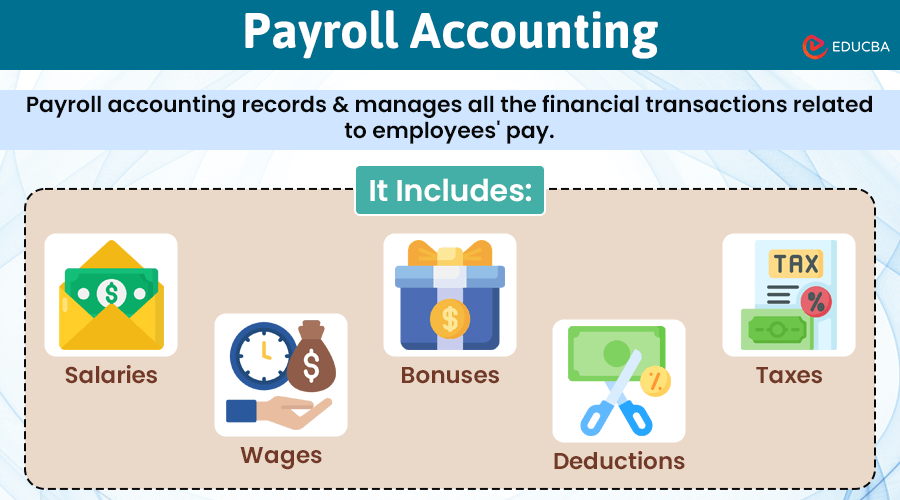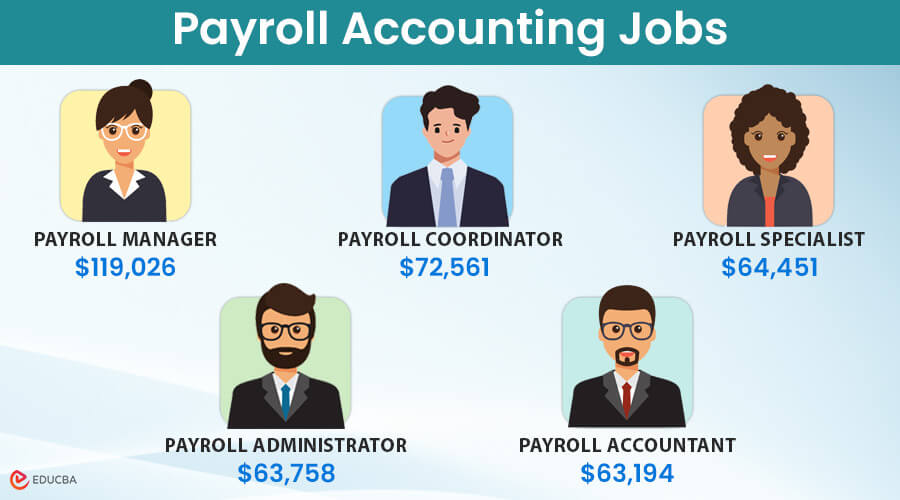
What is Payroll Accounting?
Payroll accounting records and manages all the financial transactions related to employees’ wages, salaries, bonuses, deductions, and taxes. It involves keeping track of the money a business pays its employees for their work. It includes calculating employees’ total earnings, deducting the appropriate taxes and other withholdings, and ensuring that employees are paid accurately and on time.
Payroll accounting ensures that the business pays employees the correct amount of money they are owed and complies with legal and tax obligations.
Table of Contents
What Does Payroll Accounting Include?
Payroll accounting typically includes several key components:
- Calculating Gross Pay: Determining employees’ earnings based on their hourly wages or salaries.
- Deducting Taxes: Calculating deductions such as income tax, Social Security, Medicare, and other withholdings like retirement contributions or health insurance premiums.
- Benefits Deductions: Deducting contributions for health insurance, retirement plans, and other benefits chosen by employees.
- Recording Net Pay: The amount employees receive after all deductions and withholdings.
- Payroll Reports: Generating reports for accounting purposes, including summaries of wages, taxes withheld, and employer contributions.
- Compliance: Ensuring adherence to labor laws, tax regulations, and reporting requirements.
- Payment Processing: Distributing paychecks or processing direct deposits to employees on scheduled pay dates.
Importance of Payroll Accounting
Accounts and Legal state that payroll accounting is crucial for several reasons:
- It ensures employees receive their correct wages and salaries promptly.
- Businesses must adhere to legal requirements by deducting and paying their employees’ taxes, such as income tax and social security contributions. Failing to do so can result in penalties and legal problems.
- Businesses can better understand where they stand financially by tracking payroll expenses. It helps them budget, identify areas of overspending, and make informed financial decisions.
Types of Payroll Accounting
1. Initial Recordings: It refers to the initial entry of payroll transactions into the accounting records. It includes recording employee wages or salaries, deductions (such as taxes and benefits), and employer contributions (like Social Security and Medicare taxes).
2. Accrued Payroll or Wages: Accrued payroll refers to wages earned by employees during a pay period but not yet paid out. Accrual accounting principles require recording these wages as an expense in their earned period, even if payment occurs in a subsequent period.
3. Manual Payments: They refer to any payments made outside the regular payroll processing system, such as one-time bonuses, reimbursements, or other irregular payments that are not part of the routine payroll cycle. Manual payments are significant in payroll accounting, as they represent non-routine transactions that require special handling.
Example of Payroll Accounting
Here are some examples, along with their descriptions and accounting entries:
Example 1: Direct Deposit of Net Pay
Direct deposit of employee net pay into their bank accounts.
Accounting Entries:
| Date | Particulars | Debit | Credit |
| XXX | Accrued Salaries Payable | XXX | |
| Cash | XXX |
Explanation: When paying employees via direct deposit, the company reduces the liability (Accrued Salaries Payable) by the amount of net pay transferred and decreases cash by the same amount.
Example 2: Recording Employee Salaries
This example covers Payment of employee salaries for the month of June.
Accounting Entries:
| Date | Particulars | Debit | Credit |
| XXX | Salaries Expense | XXX | |
| Cash/Bank | XXX |
Explanation: This entry records the total amount of salaries paid to employees by debiting the Salaries Expense account to increase the expense account and crediting Cash (or the Bank) to reduce the asset account as cash is paid out.
Example 3: Withholding Taxes
Deduction of federal income taxes from employee wages.
Accounting Entries:
| Date | Particulars | Debit | Credit |
| XXX | Payroll Tax Expense | XXX | |
| Accrued Payroll Taxes Payable | XXX |
Explanation: When the company withholds federal income taxes from employee wages, it records the tax expense (Payroll Tax Expense) and increases the liability (Accrued Payroll Taxes Payable) until remitting the taxes to the government.
Example 4: Employer Contributions
Contribution to employee retirement plans (e.g., 401(k)).
Accounting Entries:
| Date | Particulars | Debit | Credit |
| XXX | Payroll Expense (for employer contributions) | XXX | |
| Cash | XXX |
Explanation: When the employer contributes to an employee’s retirement plan, the company records the expense (Payroll Expense) and reduces cash (Credit) by the contribution amount.
Example 5: Employer Taxes
Payment of employer’s portion of Social Security and Medicare taxes.
Accounting Entries:
| Date | Particulars | Debit | Credit |
| XXX | Payroll Tax Expense | XXX | |
| Cash | XXX |
Explanation: When the company pays its portion of payroll taxes (e.g., Social Security, Medicare), it records the tax expense (Payroll Tax Expense) and reduces cash (Credit) by the amount paid.
Steps to Set Up a Payroll Account
Setting up payroll accounting involves several key steps to ensure accurate and compliant processing of employee payments and related taxes. Here is a basic guide to get started:
- Gather Information: Collect essential information about your employees, including their full names, addresses, Social Security numbers, tax withholding forms (like W-4 in the U.S.), and bank account details for direct deposit.
- Choose a Payroll System: Choose a payroll software or service that fits your needs. Consider factors like your business size, number of employees, payroll complexity, and budget.
- Register with Tax Authorities: Obtain an Employer Identification Number (EIN) if you already have one. Register with relevant tax authorities (IRS in the U.S., HMRC in the UK, etc.) to report payroll taxes.
- Set Up Payroll Schedule: Determine how often you will run payroll (e.g., weekly, bi-weekly, monthly) and establish a consistent schedule.
- Calculate Employee Pay: Determine gross wages for each employee based on hours worked, salary, or commission. Include any bonuses or overtime pay.
- Withhold Taxes: Deduct federal, state, and local income taxes as per employee W-4 forms. Also, withheld Social Security and Medicare taxes (FICA).
- Payroll Deductions and Contributions: Deduct voluntary deductions like health insurance premiums, retirement contributions (e.g., 401(k)), and other employee benefits.
- Employer Contributions: Calculate and contribute your portion of Social Security, Medicare, and other applicable employer taxes or contributions.
- Prepare Paychecks or Direct Deposits: Generate pay stubs detailing gross wages, deductions, and net pay. Distribute paychecks or initiate direct deposits.
- File Payroll Taxes: Submit payroll tax payments to the appropriate authorities on time. File quarterly and annual payroll tax reports (e.g., Form 941 in the U.S.).
- Maintain Records: As required by law, keep accurate records of payroll transactions, tax filings, employee earnings statements, and any relevant documentation.
Note: Stay updated on changes to tax laws, minimum wage rates, and other regulations that may affect payroll processing.
Payroll Accounting Jobs and Salary
There are various types of jobs in payroll accounting, including:
Final Thoughts
Payroll accounting is essential for businesses as it ensures employees receive accurate and timely compensation, vital for maintaining morale and productivity. Adhering to legal payroll requirements is crucial to prevent penalties and legal complications. Businesses can prioritize core operations by establishing a streamlined payroll system and employing skilled professionals while ensuring efficient payroll management.
Frequently Asked Questions (FAQs)
Q1. What role does payroll software play in payroll accounting?
Answer: Payroll software automates many payroll tasks, such as calculating wages, withholding taxes, and generating pay stubs and tax forms. It helps ensure accuracy and compliance with payroll laws.
Q2. How often do employers typically process payroll?
Answer: Payroll frequency varies by company and can be weekly, bi-weekly (every two weeks), semi-monthly (twice a month), or monthly, depending on the employer’s policy and local regulations.
Q3. What are some payroll best practices for businesses?
Answer: Best practices include maintaining accurate employee records, using payroll software for automation and compliance, regularly reviewing payroll processes for errors, ensuring timely tax filings and payments, and communicating with employees about their pay and benefits.
Q4. How does payroll accounting integrate with other accounting functions?
Answer: Payroll accounting interacts closely with other accounting functions such as financial reporting (including accruals for wages and benefits), budgeting and forecasting (for labor costs), and tax accounting (for compliance with tax laws).
Recommended Articles
We hope this comprehensive post on payroll accounting resolves your queries on the subject. Here are more accounting-based articles.


